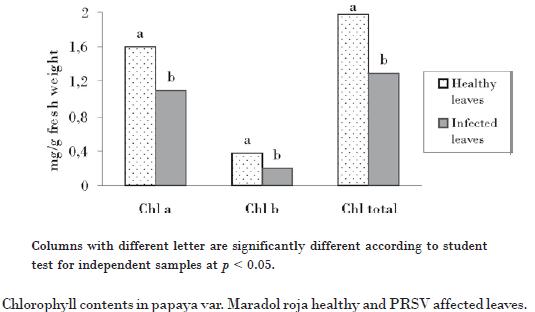Mi SciELO
Servicios Personalizados
Revista
Articulo
Indicadores
-
 Citado por SciELO
Citado por SciELO
Links relacionados
-
 Similares en
SciELO
Similares en
SciELO
Compartir
Fitosanidad
versión impresa ISSN 1562-3009versión On-line ISSN 1818-1686
Fitosanidad v.13 n.2 Ciudad de la Habana abr.-jun. 2009
Comunicación Corta
Alterations Induced by Papaya Ringspot Potyvirus on Chlorophyll Content in Papya (Carica papaya L.) Leaves
Alteraciones del contenido de clorofila inducidas por el potyvirus de la mancha anillada en hojas de papaya (Carica papaya L.)
Dariel Cabrera Mederos¹, Rafael Sosa Martínez¹, Orelvis Portal Villafaña¹, Yasiel Alburquerque Alfonso¹, José E. González Ramírez² and Ricardo Hernández Pérez³
¹Universidad Central Marta Abreu. Carretera a Camajuaní Km 5½, Santa Clara, Villa Clara, Cuba, dcabreram@uclv.edu.cu
²Instituto de Investigaciones en Viandas Tropicales. Apdo. 6, Santo Domingo, Villa Clara, Cuba
³Centro de Estudio para la Transformación Agraria Sostenible. Universidad de Cienfuegos, Carretera a Rodas Km 3, Cienfuegos, Cuba
Papaya ringspot virus (PRSV-p) genus Potyvirus, family Potyviridae is an aphid-transmitted plant virus [Tripathi et al., 2008]. This virus infects papaya (Carica papaya L.) naturally and it is a major limiting factor in its production worldwide [Purcifull et al., 1984]. Its presence in Cuba was first recorded in 1946 [Acuña and Zayas, 1946] which represents the main problem concerning planting nowadays [Pérez and González, 2007; Cabrera et al., 2008]. The first symptoms developed by this virus are the chlorosis in the youngest papaya leaves, followed by a mosaic that varies in intensity and progress until the leaves become mottled and distorted. Either the virus course and its effects and severity depend on the viral isolate. According to Hull (2004), direct effects on the photosynthetic apparatus is the most obvious and perhaps the most common way by which viral infection reduces plant size.
The objective of this work was to determine the direct effect of one severe isolate (PRSV-VC) on the chlorophyll (Chl) content in papaya leaves var. Maradol roja.
The presence of the PRSV was checked by enzymelinked immunosorbent assay (ELISA) [Clark and Adams, 1977]. Absorbance readings (405 nm) were taken by a Bio-tec ELx-800 automated microplate reader. Fully developed leaves disks (1 cm diameter) displaying intense mosaics were taken in order to compare them with healthy plant leaves. In both cases, the extraction of the pigment was done by using the dimethylsulphoxide (DMSO) method [Hiscox and Israelstam, 1979]. According to Djurdjevic et al. (2007), a millilitre of solvent was applied to each papaya leaf disk and then incubated during 30 minutes at 60°C. The samples reading was carried out with two wavelengths (645 and 663 nm), in an ultraviolet-visible spectrophotometer. Statistical analysis of the results was obtained by using the statistical package Statgraphic plus 5.0 for Windows.
The chlorophyll a, chlorophyll b and total chlorophyll contents were determined spectrophotometrically by using Arnon's equation [Porra, 2002; Djurdjevic et al., 2007] and expressed in mg/g of fresh leaf weight.

Chlorophyll a, chlorophyll b and total chlorophyll contents showed significant differences when comparing the obtained indexes from healthy and infected plant leaves (Fig.).

It was observed that all analyzed samples showed a higher content of chl a than chl b in an approximately 5:1 ratio. These results are in agreement with those of Nobel (2005) who found that the ratio of chl a to chl b is usually about 3:1. Hopkins and Hüner (2004), mention that the chlorophyll a is the primary photosynthetic pigment in all higher plant.
Infection by PRSV in papaya plants provoked a significant reduction on pigment contents in those leaves showing an intense mosaic (Fig.). This could be closely related to a considerable loss on photosynthetic efficiency in the affected plants. The correlation obtained between the appearance of mosaic symptoms and the reduction of chlorophyll contents were pointed by Hull (2004) when referring to diseases caused by viruses in general.
REFERENCES
Acuña, J.; F. Zayas: «El mosaico y otras enfermedades de la frutabomba (Carica papaya L.)», Circular 85, Estación Experimental Agronómica de Santiago de las Vegas, La Habana, 1946.
Cabrera, D.; O. Portal; M. Cruz; R. Hernández: «Papaya ringspot virus (PRSV-P): Aspectos biológicos y epidemiológicos», (Resúmenes) VIII Simposio Internacional de Biotecnología Vegetal, 23-25 de abril, Villa Clara, Cuba, 2008.
Clark, M. F.; A. N. Adams: «Characteristics of the Microplate Method of Enzyme-linked Immunosorbent Assay for the Detection of Plant Viruses», Journal of General Virology 34:475-483, Inglaterra, 1977.
Djurdjevic, L.; M. Mitrovic; P. Pavlovic: «Methodology of Allelopathy Research: Forest Ecosystems», Allelopathy Journal 20:79-102, India, 2007.
Hiscox J. D.; G. F. Israelstam: «A Method for the Extraction of Chlorophyll from Leaf Tissue Without Maceration», Canadian Journal of Botany 57:1332-1334, Canadá, 1979.
Hopkins W. G.; N. P. A. Hüner: Introduction to Plant Physiology, 3rd ed., Wiley, EE.UU., 2004, p. 53.
Hull, R.: Matthew's Plant Virology, 4th ed. Elsevier, EE.UU., 2004, p. 1001.
Nobel, P. S.: Physicochemical and Environmental Plant Physiology, 3rd ed., Elsevier, EE.UU., 2005, p. 222.
Pérez, L. F.; G. González: Enfermedades del papayo: Descripción, epidemiología y manejo, Ed. Científico-Técnica, La Habana, 2007, p. 52.
Porra, R. J.: «The Chequered History of the Development and Use of Simultaneous Equations for the Accurate Determination of Chlorophylls a and b», Photosynthesis Research 73:149-156, Holanda, 2002.
Purcifull, D. E.; J. R. Edwardson; E. Hiebert; D. Gonsálves: «Papaya Ringspot Virus», CMI/AAB Descriptions of Plant Viruses no. 292, Inglaterra, 1984.
Tripathi, S.; J. Y. Suzuki; S. A. Ferreira; D. Gonsálves: «Papaya Ringspot Virus-P: Characteristics, Pathogenicity, Sequence Variability and Control», Molecular Plant Pathology 9:269-280, EE.UU., 2008.














